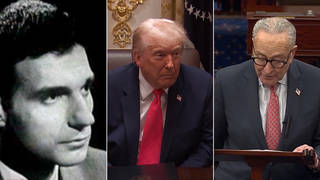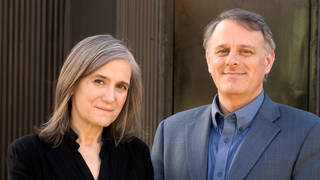
Guests
- Simón Mejíathe founder and a member of the Colombian Grammy Award-winning band Bomba Estéreo.
Simón Mejía, the founder and a member of the Colombian Grammy Award-winning band Bomba Estéreo, recently spoke with Democracy Now! about the election of Francia Márquez Mina as Colombia’s first Afro-Colombian vice president and about the band’s new film project that centers the resistance, experiences and traditions of Afro-Colombians, called “El Duende,” a musical journey on Colombia’s Pacific coast. The film follows the story of the Dinastía Torres, a family of marimba instrumentalists with African ancestral roots.
Click here to watch our interview with Simón Mejía in Spanish.
Transcript
AMY GOODMAN: This is Democracy Now!, democracynow.org, The War and Peace Report. I’m Amy Goodman.
Colombia made history last month as voters elected former guerrilla member Gustavo Petro as the country’s first leftist president and environmental activist Francia Márquez Mina as the country’s first Afro-Colombian vice president. Márquez is a prominent land and water defender, winner of the 2018 Goldman Environmental Prize. She helped organize the women of the community of La Toma in Colombia’s Pacific southwest region of Cauca to stop illegal gold mining by multinational corporations and other illegal miners on their ancestral land. Despite threats from multinational corporations and paramilitaries, she continued to fight back in defense of the Earth.
Well, a new music and film project by the Grammy Award-winning Colombian band Bomba Estéreo centers the resistance, experiences and traditions of Afro-Colombians, people who have long faced violence and repression from right-wing governments and paramilitaries, drug traffickers and multinational corporations seeking to exploit sacred natural resources in the region. The project is called Bomba Estéreo Presents, El Duende, a musical journey on Colombia’s Pacific coast. The film follows the story of the Dinastía Torres, a family of marimba instrumentalists with African ancestral roots. This is a clip of the film’s debut soundtrack single, “Mamita.”
NARRATOR: [translated] My dad taught us, and we all learned to make instruments, to dance and everything. When dad made these instruments here in Guapi, the priests would send him to take them to the house. They would call him over the loudspeakers: “The Torres are coming. They’re coming to play.” We would arrive here. We would start playing and dancing.
AMY GOODMAN: For more, we’re joined by Simón Mejía, the founder and a member of the Grammy Award-winning Colombian band Bomba Estéreo. Simón Mejía, whose solo artistic name is Monte, will showcase the film here in New York City on July 22nd.
Welcome to Democracy Now!, Simón. It’s an honor to have you with us.
SIMÓN MEJÍA: Hello. Good morning. And thank you for having me. It’s an honor.
AMY GOODMAN: So, if you could start off by talking about the significance of this election, to have a former guerrilla become the president of Colombia, Gustavo Petro, and the vice president being the first Afro-Colombian in Colombian history as vice president?
SIMÓN MEJÍA: Yeah, well, I think it’s historical. It’s historical for Colombia, because you know that Colombia has been, for — I will say, for centuries, right-oriented in terms of politics. And all the left candidates that we have in recent history that were candidates for presidency were killed. So, having this person that was from a very symbolic guerrilla here in Colombia that was called M-19, a left-orientated, choosing him as vice president Francia Márquez, that is a social and environmental leader, in a country where more environmental and social leaders are killed in the world, is really symbolic.
And it’s really — it brings hope, hope to the people, to the underrepresented people of the periphery of Colombia, who are the ones that voted for Gustavo Petro, the Afro communities, the Indigenous communities, the campesinos, the farmers, the poor people around the country that have been undertaken for years and years. So, it’s a good time for change. There is hope in the air. We don’t know what’s going to happen, but the good thing is that there is hope in the air. And I feel when there’s hope in the air, there’s light at the end of the tunnel. So, we’ll see what happens, and people are really excited about this.
And I think that regarding what’s happening to the — in the world, that you see that everything is turning to the right. Having Colombia and many other countries in Latin America turning to a center, to a left is very symbolic of how this Latin America piece of the Earth and Central America might be really important for the future of politics in the world, especially if we unite as one bloc, not just small countries, but one bloc, protecting our environment and asking for things from the First World countries.
AMY GOODMAN: Simón, many of your recent projects with Bomba Estéreo center the experiences of the Afro-Colombian and Indigenous communities of Colombia, like Cauca, where Francia Márquez Mina is from. If you can talk about why this is so important to you, and the role of music in resistance?
SIMÓN MEJÍA: Yeah. Well, first of all, I have to say that Bomba Estéreo, its first inspiration to be a band and to make music was the folk music from Colombia, especially from the Caribbean coast, because here in Colombia we have lots of diversity in music, and the Caribbean coast music is very different from the Pacific coast music. So, Bomba Estéreo’s first inspiration was the folk music from the Caribbean coast, that is mainly the more renowned genre and rhythm, is cumbia. Cumbia was born here in Colombia many centuries ago when the African slaves entered and joined with the Indigenous communities and started playing music. That was the birth of cumbia music. So, we, Bomba Estéreo, were inspired by this cumbia, mixing it with electronic music. So we owe, when we are as a band, to that music and to those communities that have been inhabiting this territory for centuries, the Blacks and the Indigenous.
So, then, I think we’re honoring this music and telling the stories behind this music that many people around the world, even people here in Colombia, don’t know the story and the — the history and the stories that are behind this kind of music, that happened in really natural places of the country, in the jungle, in the Pacific rainforest, that is a huge jungle that goes from Panama to Ecuador, in the Amazon jungle that we share with Brazil and Peru and Ecuador, and in the Caribbean coast, in the Guajira desert. So, this music happens in really strong natural spots, so the relationship between nature and that music is really beautiful. And we try to honor that with our music, that is a more modern music, but it’s always paying honor to where we come from and where our roots, cultural, social and human roots, are, here in those kind of places and in those kind of communities.
AMY GOODMAN: What kind of sounds can you hear in the — oh, the remote areas of Colombia, such as the Amazon and the Pacific region? Talk about the oral traditions that you feel need to be documented.
SIMÓN MEJÍA: Yeah. So, the sounds are really diverse, for example. And I think, regarding the documentation, is that sometimes we don’t know what’s going to happen in the future, and we don’t know what’s going to happen if modernization enters the Amazon jungle or the Pacific rainforest. Hopefully not. Hopefully we protect those places that are key and essential to what’s happening today, environmentally speaking, climate change and everything.
But you go to those places, and, for example, in the Pacific rainforest, where this movie was made, El Duende, the marimba is the main instrument. And the marimba is kind of a recreation — and when you speak with the people there and everything — of the rivers, because the Pacific rainforest is full of water. It’s one of the most places in the world with more water. It’s really impressive. And in general terms, Colombia is a country of water. That’s really our treasure that we have to protect and preserve, is the water. So you hear the marimba and the marimba players, and it just sounds like rivers. It’s like the rivers speaking, no? The rivers speaking. Then the other instruments recreate the sounds of nature. The drums they play recreate the rhythms of nature. The maracas or the seeds recreate the sound of the trees. And then, in the Caribbean coast, for example, we have plenty of flutes. Also in the Amazon jungle, the flutes are Indigenous — are originally Indigenous. And the drums are more brought from Africa. And the flutes, they recreate the birds singing. So, I think all folk music from Colombia, Afro and Indigenous, is just a praise to nature, is just nature speaking, the strong nature from Colombia speaking through these instruments. And that, for me, makes that music really sublime, immortal and beautiful, and beautiful.
AMY GOODMAN: Can you talk about El Duende, the whole music and film project that you’re involved with? Begin with a translation of El Duende.
SIMÓN MEJÍA: Yeah, El Duende translates to “the elf.” El Duende is “the elf.” And it began as a music project with a friend of mine that has this record label here in Colombia. It’s called Palenque Records. He has been documenting Afro music from Colombia, like 20 or 30 years ago, so he’s constantly recording bands in the Caribbean, in the Pacific, like African heritage music. And he did this beautiful album with the Dinastía Torres, that is a group of — a band of three brothers that live in the Colombian Pacific just beside the Río Guape and play the marimba and the drums. And they have inherited this tradition from Africa orally up until now. This is centuries, centuries tradition. So, he had this album of just purely folk music, and he asked me to do some remixes, like electronic remixes of the music.
And I started doing the remixes. And I was always thinking, I want to tell the story behind this music, where this music comes from, who are the characters. So I started asking him for material, like interviews, because he’s also a filmmaker. So I asked him for interviews with the guys, with the musicians. And he started sending me audios of interviews. And I started putting the interviews inside the remixes. And then I jumped into: This has to be a film. No? We want to see who is speaking, who is telling these magical stories. So, again, he sent me material of a movie he did that is called Divinas Melodías, also in the Pacific coast. And we started making this kind of collage, video clip, experimental process, all around one idea that is the myth of El Duende, the myth of the elf.
And that myth, that is also orally — has passed orally through generations and generations of these people in the Pacific coast, is kind of similar to that myth that you guys have in North America with the blues music, that myth of the crossroads, that the guitar players, the blues guitar players, go to a road and walk, and they meet with the devil, and the devil teaches them how to play the guitar. Well, now this myth happens here in the jungle and says that marimba players have to go to the jungle, be there for many, many days without food, without water, just waiting. And then suddenly, this being that is El Duende, the elf, a kind of middle-elf, middle-devil, appears, and he teaches them how to play the marimba and how to build the marimba, because these guys also build the instrument from the trees, and they tune it by ear. They don’t have any musical training, just oral heritage. And that’s the myth, that real marimba player — the good marimba players of the Colombian Pacific jungle learn how to play it with El Duende in the middle of the jungle. So, it’s kind of beautiful, surreal, and we wanted to bring that into images, into music. So you see the short film as real experimental, kind of surrealistic, magical, but it’s kind of about this story behind this this myth.
AMY GOODMAN: Simón Mejía, I wanted to ask you about the film that you were featured in in 2020, Sonic Forest, which follows your journey across the Colombian Pacific coast, spending several weeks with Afro-Colombian and Indigenous communities, who have been on the frontlines of the violence and the killing, Colombia one of the most violent places, lethal places for environmentalists all over the planet. Can you talk about what you learned on that journey and what you want to convey to the world through your music and your research?
SIMÓN MEJÍA: Yes. That was a project that we made with an NGO, a North American NGO, environmental. It’s a purely environmental film. And we did it with an organization that is called Stand for Trees. They do these projects all around the world linking forest conservation with carbon credits. So, we were invited by them to do the piece of Colombia, that was meant — that is and happens in the Pacific rainforest in Colombia.
Pacific rainforest is a forest almost as important as the Amazon jungle for Colombia and for the world. It’s one of the most biodiverse jungles in the world. It’s full of water. It’s impressive, full of water. But at the same time, it’s one of the most conflicted places in Colombia, because there’s illegal and legal gold mining, and there are routes of drug trafficking. I have to say that the drug trafficking is the main problem here in Colombia — not drug trafficking, but I think cocaine being illegal is the engine to all the deaths that we have in Mexico and in Colombia. So, I will have to say also that anyone around the world who buys cocaine is carrying death here in Mexico and in Colombia. So, if they don’t legalize it, the problem will be forever, and we’ll have death and violence forever in the countries that are involved in this illegal business that should be legal.
So, this film, it wasn’t about drug trafficking. It was about projects, of communitary projects in the Pacific, Afro — one Afro and one Indigenous, that are protecting thousands and millions and millions of hectares of forest, in exchange of carbon credits. That’s how they finance — finance, do the work and do their work and protect the jungle. And the objective of the film was just to have a pair — a musician or an artist to go and show that to the world, know how these communities are protecting forests, that they are key to climate balance, key to climate change and key to absorbing all the carbon that is in the atmosphere.
So, we went there, and as I was a musician, we related it with music. So I was with the communities. We did, like, musical encounters. And in the middle of the musical encounter, we’d talk about the work they do for protecting this forest, the menaces that they have. And it was beautiful, because it was offering the Indigenous community — they live each by the side, but it was knowing the process behind all this huge and really important work that they do, facing real dangers, because protecting forests here in Colombia is a dangerous task. And being a social or environmental leader is really dangerous in Colombia, because they kill them. They kill them. So, visualizing this is a way to show to the world the important — the thing that they do and how important it is and how important it is to protect these people, as well.
AMY GOODMAN: You’re also called Monte. How come?
SIMÓN MEJÍA: Yeah, I have plenty of — I like to work this and the other and many projects at the same time. And Monte is one of them, is one of them just to explore more around music and nature sounds and documentary filmmaking.
AMY GOODMAN: Well, thank you again, Simón Mejía, founder and member of the Grammy Award-winning Colombian band Bomba Estéreo, which has a new film and music project that celebrates Afro-Colombian traditions and traces the history of the marimba on Colombia’s Pacific coast. It’s titled Bomba Estéreo Presents, El Duende, the elf. The first part of the project is titled Mamita. We thank you so much for being with us. Your latest album titled Deja, which was split into four sections — Agua, Aire, Tierra and Fuego — Water, Air, Earth and Fire. To see our conversation in Spanish, go to democracynow.org. I’m Amy Goodman. Thanks so much for joining us.












Media Options